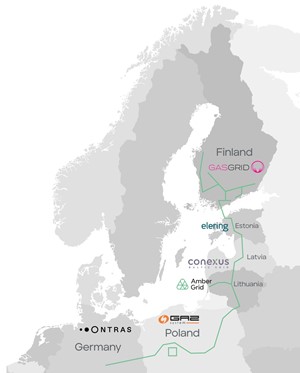News
Amber Grid launches international tender for H2 corridor pre-feasibility study
Amber Grid, on behalf of the Nordic-Baltic H2 Corridor project partners has launched an international tender for a pre-feasibility study. This is another important step in the development of Europe’s H2 infrastructure, following the signing of a cooperation agreement between transmission system operators of six European Union countries on the implementation of a cross-border project, the Nordic-Baltic H2 Corridor, last December.
The European gas transmission system operators Gasgrid Finland (Finand), Elering (Estonia), Conexus Baltic Grid (Latvia), Amber Grid (Lithuania), GAZ-SYSTEM (Poland) and ONTRAS (Germany) are developing a H2 supply infrastructure from Finland through Estonia, Latvia, Lithuania and Poland to Germany - the Nordic-Baltic H2 Corridor. The aim of the project is to connect the green energy production regions in Northern Europe with the main consumption centers in Central Europe. The project is expected to be completed by 2030.
“The pre-feasibility study, the initial results whereof should be available by the end of this year, will analyze European and regional energy policies and provide specific answers on the potential for green and low-carbon H2 production and consumption. The study will also make recommendations on project scope, possible pipeline routing, financing, timing and risk management. Also, possible location of storage will be investigated. The results of the study will be of key importance for the region as a whole, which is currently actively seeking opportunities to develop a H2 ecosystem from Finland through the Baltic States to Central Europe,” said Nemunas Biknius, CEO of Amber Grid, the Lithuanian gas transmission system operator.
Based on the recommendations of the H2 corridor pre-feasibility study, a decision will be taken on the further development of the project. It is now assessed that the H2 corridor may well create significant opportunities for the development of energy and related ecosystems. It will stimulate the demand for and development of green electricity, accelerate the development of the H2 economy and will therefore contribute to the European climate targets. It also creates the conditions for investment in industrial and technological innovation, reduces the cost of energy transport, creates jobs and generate additional revenue for countries.
H2 is expected to become one of the main energy carriers in Europe as the EU Member States undergo dynamic changes linked to energy transformation and economic decarbonization. It will strengthen the EU's energy security, reduce dependence on imported fossil energy and play an important role in reducing the dependence of energy-intensive European industries on imported fossil fuels. In addition, the project will make a significant contribution to the EU’s greenhouse gas emission reduction target by helping to replace the use of fossil fuels in the industrial, transport and energy sectors with green and low-carbon H2, produced from electricity.


